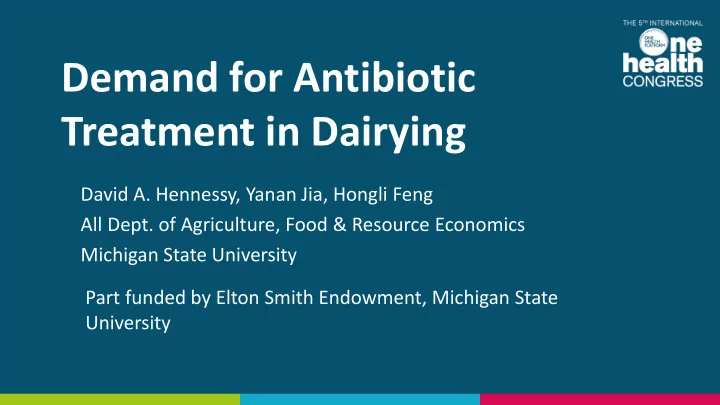

Demand for Antibiotic Treatment in Dairying David A. Hennessy, Yanan Jia, Hongli Feng All Dept. of Agriculture, Food & Resource Economics Michigan State University Part funded by Elton Smith Endowment, Michigan State University
Motivation Source://www.youtube.com/ Antibiotics have been widely applied watch?v=1lZF8mSRq4Q in animal agriculture, for A. Growth promotion B. Disease prevention C. Disease treatment Through much of world, efforts to reduce applications. US FDA Veterinary Feed Directive has sought to eliminate Purpose A and reduce B-C In dairying, A is not an issue and C is the major issue for mastitis purposes
Purpose Our focus is managerial economics of farm-level antibiotics choices. Research reveals strong pressures on human medicine doctors to over- prescribe antibiotics (e.g., Linder et al. 2017) As with others, evidence that farmers may, through rational inattention or irrationality, mismanage their inputs (e.g., Perry et al. 2017) and risk protection (Du et al. 2017) We seeks to understand whether opportunities exist for behavioral (non-traditional) economics approaches to reduce antibiotics demand on dairy farms
Graphical Perspective Antibiotics quantity used Actual (????), due to decisionmaking and related issues Privately best accounting only for farm profit Socially best, accounting for risk to human medicines 0
Survey Source: https://hoards.com/article-20125-calf -feeding-changes-are-on-the-way.html Lake State Dairy Farm Business Viability Survey sent to farmers in Wisconsin, Minnesota + Michigan. Paper and web versions, March-September 2017, 21% response rate Section on antibiotics asks how used, MI MN WI Total what costs, 118 171 392 688 willingness to pay for treatment
How used Do you have written protocols? Size <100 cows 100-499 cows 500+ cows Organic Total Yes 50.4% 74.4% 88.2% 51.9% 60.9% No 49.6% 25.6% 11.8% 48.1% 39.1% Total 355 153 76 52 636 Function Uses Treat current infection Prevention 87.7% 70.3% 62.7%
Nature of Median cost per case Losses Diagnosis $5 Therapeutics $30 Data Non-saleable milk $80 Mean loss per cow comparable per year if can’t use Veterinary service $15 to Rollin et al Small $1,834 Labor $15 Medium $462 Therapeutics Death loss $34 as share Large $454 Lost future milk $200 <5% Average $1,252 Premature culling $200 Lost future reproduction $100
Willingness to Pay for Antibiotics Treatment Loss Cow not performing $100 $150 $200 $250 optimally. Probability You isolate. 0.40 $103 $127 $117 $102 There is a probability 0.55 $137 $131 $122 $138 she can be cured by 0.70 $154 $153 $166 $196 antibiotics and a loss avoided if she is. 0.85 $169 $172 $196 $198 What are you WTP? Only WTP not significantly larger than expected loss avoided
Fitted Model, what do farmers worry about? *Figure shows how probability Fitted quadratic model, and loss avoided trade off to keep WTP = f(prob., loss avoided) WTP at $100. *Fitted curve shallower than Probability expected loss curve *Farmers are more keen to increase probability of loss Classic expected loss model, avoided than to increase WTP = prob. ´ loss avoided magnitude of loss avoided Loss avoided
Further Evidence Please identify most & least IMPORTANT factors % % for your operation in regard to managing mastitis most least Increasing prob. treatment successful 59.8 12.8 Managing treatment cost 7.0 64.3 Reducing loss if cow infected & treatment effective 33.1 22.9 Total 513 507
Four Policy Points Direct question suggests tax on antibiotics use would be ineffective. Cost very small compared with other costs. Bureaucracy + linking with vet time likely more effective WTP model suggests increasing loss avoided (e.g., with premium for better quality milk) may not increase demand for antibiotics much when compared with more effective antibiotics Farmers keen to reduce risk of loss but not so cost focused may over-apply, even from private optimum stand-point (diagram) Farmers may be WTP for better diagnostics to increase probability of success and this need not increase demand for antibiotics
References Du X, H Feng, DA Hennessy. 2017. Rationality of choices in subsidized crop insurance markets. Amer. J. Agric. Econ. 99(3), 732-756. Linder JA. 2017. Influencing antibiotic prescribing behavior: Outpatient practices. Presentation, Feinberg Sch. Med., Northwestern Univ., Sept. 9. Perry E, G Moschini, DA Hennessy. 2017. Product formulation and glyphosate use: Confusion or rational behavior? Selected paper, AAEA Annual Meetings, Chicago, IL. Rollin E, KC Dhuyvetter, MW Overton. 2015. The cost of clinical mastitis in the first 30 days of lactation: An economic modeling tool. Prev. Vet Med. 122(3), 257-262.
Recommend
More recommend